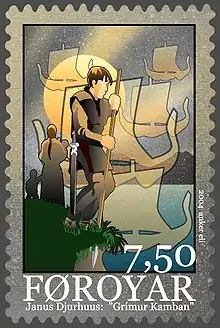Grímur Kamban
Grímr Kamban was, according to the Færeyinga saga, the first Norse settler in the Faroe Islands. The modern Faroese form of the name is Grímur, but it was Grímr in Old Norse and is often anglicised as Grim.[1]
Grímur Kamban | |
|---|---|
| Born | 8/9th century |
| Died | 9/10th century |
| Nationality | Norwegian? (Norse)? |
| Occupation | Settler |
| Known for | First Norse to appear in Faroe Islands |

Settlement of the Faroe Islands
The saga says he was a Norwegian Viking escaping the tyranny of the Norwegian King Harald (Haraldr Hárfagri). However, this is an error in this saga, because Harald's age was in the late 9th century, while the first Norse settlers reached the Faroes after 825.[2]
- "According to the Færeyinga saga... the first settler in the Faroe Islands was a man named Grímr Kamban – Hann bygdi fyrstr Færeyar, it may have been the land taking of Grímr and his followers that caused the anchorites to leave... the nickname Kamban is probably Gaelic and one interpretation is that the word refers to some physical handicap, another that it may point to his prowess as a sportsman. Probably he came as a young man to the Faroe Islands by way of Viking Ireland, and local tradition has it that he settled at Funningur in Eysturoy."[3]
It is said that he settled down in Funningur on Eysturoy.[4] The name funningur means finding. Excavations have shown Viking era houses in this area, as well as all over the Faroes.[5]
Name
Grímr is an Old Norse name. The name Kamban indicates Celtic origins. Thus he could have been a man from Ireland, Western Isles or Isle of Man, where the Vikings already had settlements. Another theory says, he could have been an early Christianized Norwegian under the influence of Irish monks there.
If Gaelic, the first part of Kamban would originate in the Old Gaelic camb "crooked". The name Kamban is therefore most likely be derived from cambán "crooked one" (c.f. Modern Irish camán, Scots Gaelic caman and Manx camane). The root camb is also found in the Gaelic names Campbell (originally caimbeul) "crooked-mouth" and Cameron (camshròn) "crooked nose", as well as the sports term cambóg, which in Gaelic refers to the type of stick used in games like hurling, hockey and golf.
Tribute
On 20 September 2004, the Faroese post office issued a stamp including honoring the poem Grímur Kamban by Faroese poet Janus Djurhuus (1881–1948). [6] [7]
References
- "825 – Grímur Kamban arrived at Faroe islands". vikinghistorytales.blogspot.com. Retrieved 1 November 2019.
- "Grímur Kamban". visitrunavik.fo. 19 August 2019. Retrieved 1 November 2019.
- Schei, Liv Kjørsvik & Moberg, Gunnie (2003) The Faroe Islands. Birlinn.
- "Funningur / Færøerne /" (in Danish). Faroeislands.dk. Retrieved 20 August 2013.
- Símun V. Arge (2014). "GrViking Faroes: Settlement, Paleoeconomy, and Chronology". Journal of the North Atlantic. 7: 1–17. doi:10.3721/037.002.sp701. S2CID 162812835.
- "Grímur Kamban". faroeartstamps.fo. Archived from the original on 7 August 2007. Retrieved 1 November 2019.
- Wayne A. O'Neil (1963). "Linguistic Structures in Djurhuus's "Grímur Kamban"". Scandinavian Studies. 35 (4): 325–332. JSTOR 40916487.
Related reading
- John Haywood (2016) Northmen: The Viking Saga, AD 793–1241 (Macmillan) ISBN 9781250106155
External links
- Sverri Dahl: The Norse settlement of the Faroe Islands (Medieval Archaeology 14, 1970, London, s. 60–73)